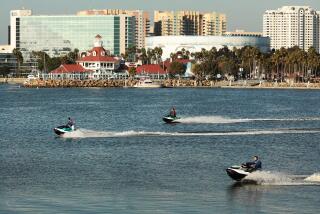Laguna Seeks Fare Approach to Congestion
Spilling from a steep and leafy hillside, the seaside village of Laguna Beach, with its funky mix of art galleries, chic restaurants and specialty stores, bustles with visitors from around the world.
The tourism boom, however welcome for merchants, has left civic leaders grappling with a traffic and parking crunch that has some of its 25,000 residents driving to surrounding coastal communities to shop and dine.
In an experiment that smacks of the town’s laid back eclecticism, Laguna Beach plans to subsidize door-to-door, on-demand taxi rides to provide the locals with hassle-free nights on the town.
The pilot project, which would begin next year if approved as expected at tonight’s City Council meeting, was hatched by Councilman Paul Freeman, who doesn’t know if it has been tried anywhere else.
Subsidized taxi programs have been around for years, but typically they serve elderly and indigent populations who don’t drive or have cars to get them to hospitals, supermarkets and their jobs. “I’ve never heard of anything like this,” said Fred Sater, spokesman and 19-year veteran of the Division of Tourism at the California Trade and Commerce Agency. “Nothing even close.”
Some residents, especially those farthest away, endorse the project. Others, however, question whether it’s necessary, and even suggest it’s the price of living in such a beautiful place.
“It’s tough when you live in paradise,” said Nancy Beverage, who’s lived in town for nearly two decades and is willing to put up with the hassles that come along with Laguna’s popularity. “Everyone wants to come here.”
Served by only two major access roads and offering 2,000 parking spots along its narrow downtown roads, Laguna Beach draws an estimated 3 million visitors each year, most of them day-trippers strolling to art shows, bistros, bars and the beach.
The city has a bus system, which it augments during busier summer months with hourly shuttles that ferry passengers from outlying lots and provides service within residential neighborhoods. But buses stop running at 6 p.m., a restrictive schedule for anyone seeking a night on the town.
With the taxi service, residents would be able to hail cabs within city limits from 5:30 p.m. to 2:30 a.m. Cab companies that agree to participate would be paid a flat fee of $8 for rides. Residents would buy $2 vouchers from the city, which drivers would turn in for the $6 balance.
Initially, $20,000 is to be earmarked for the pilot project, which would be enough for 3,333 rides. The service could begin as early as January, its length depending on how popular it becomes.
Freeman proposes the project be paid with funds from the State Local Transit Fund, which is administered by the Orange County Transportation Authority. Various taxi companies have expressed interest in participating, he added.
“We know there’ll be a number that will be happy to participate,” he said. “Theoretically, it could be a big boon to their business. I don’t care either way. I just want to see if we can help people get around easier in their town.”
City officials first considered expanding bus operations. But Freeman estimated it would be less expensive to try out a taxi service.
“It’s a very small part of the solution, but we have to look at public transportation to make it more convenient for residents to enjoy their own town,” Freeman said. He stressed the project is only an experiment and perhaps the beginning of a bigger plan.
“I think, ultimately, Laguna Beach is going to have to do something more substantial about confronting the congestion and circulation problems. We’re going to have to if it’s going to be a place people can enjoy.”
Mike Beanan, vice president of the South Laguna Civic Assn., thinks the taxi plan is a good start. He noted that many residents in his end of the city head to Dana Point to avoid the traffic delays and fight for parking.
“Since we live the farthest from the center of town, we would probably benefit the most,” he said.
Merchants also endorsed the idea, saying employees and patrons hunger equally for parking.
“Most of our customers will have a meter running while they’re eating. A lot of people stress about it,” said Janice De Pfyffer, manager of BJ’s Pizza and Grill, which faces the main beach. “We have most of our employees park at the high school and when they’re off their shift, the delivery drivers take them back up if it’s dark.
“Parking is a nightmare. It’s annoying,” she said.
But other residents questioned whether there’s really a need for such a service for locals, noting that many in the upscale community can easily afford taxi fares on their own. And others are so familiar with the streets and alleys that they know where to find a spot even during the height of summer.
“There’s times that you know it’s going to be tough,” said Donna Bader, a resident since 1980. “But you always find a space. It’s just a matter of how far you have to walk to where you want to go.
“If I don’t find space immediately, I can go to my secret little places. And I’m not going to tell you where they are.”
More to Read
Sign up for Essential California
The most important California stories and recommendations in your inbox every morning.
You may occasionally receive promotional content from the Los Angeles Times.










